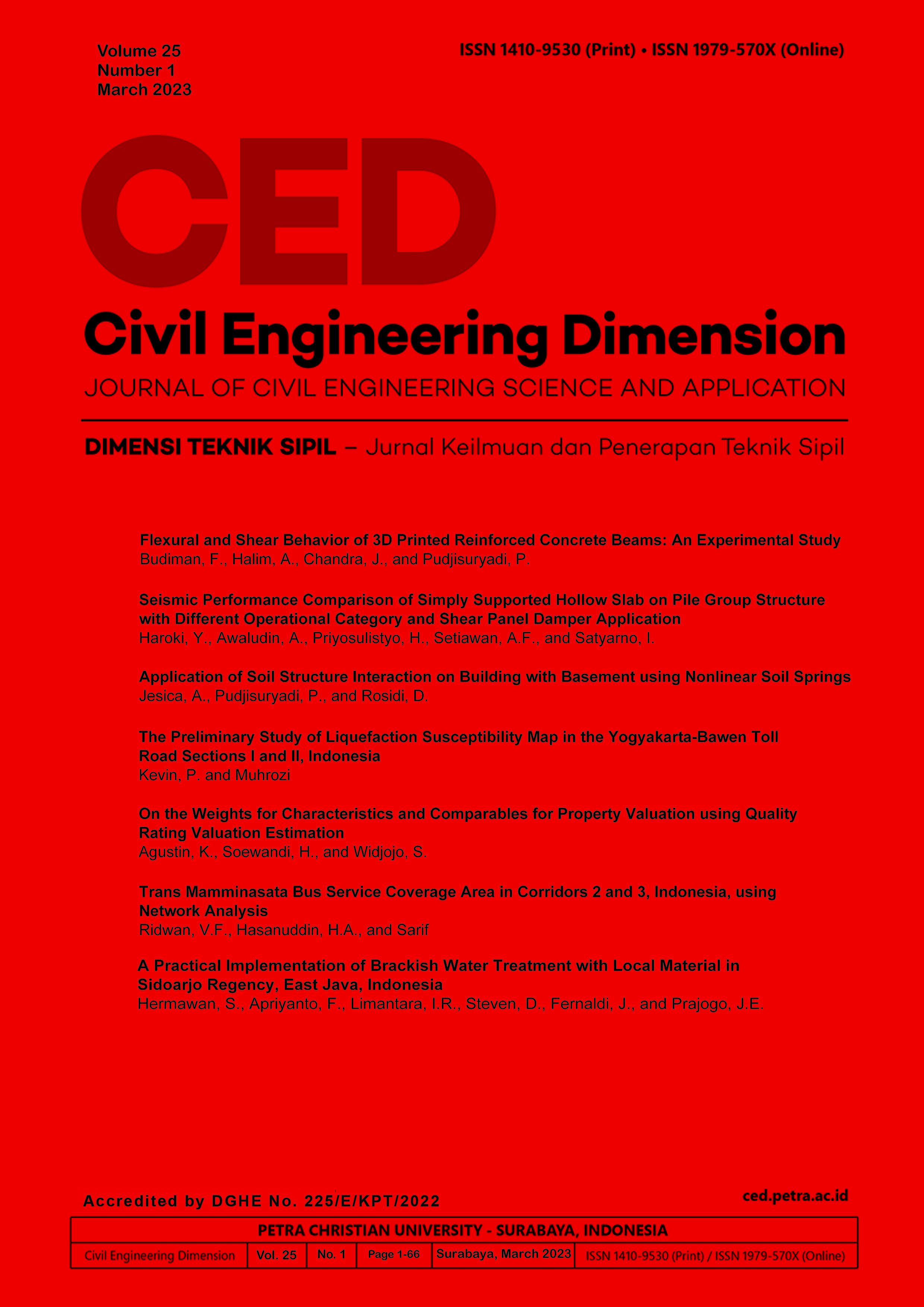Trans Mamminasata Bus Service Coverage Area in Corridors 2 and 3, Indonesia, using Network Analysis
DOI:
https://doi.org/10.9744/ced.25.1.48-52Keywords:
Trans Mamminasata Bus, Teman Bus, network analysis, service area, QGISAbstract
This study examines issues related to the Trans Mamminasata Bus/Teman Bus, Indonesia, particularly in Corridors 2 and 3. Using primary and secondary data obtained from a survey, this study explores the service coverage area for three facilities (housing facilities, government and educational infrastructures) along the Corridors 2 and 3 using network analysis in Quantum GIS (QGIS). Two variables, pedestrian distance (400 meters) and cyclist distance (2000 meters), were applied in this study. The results showed that Corridor 2 served 86 infrastructures for the pedestrian distance variable and 367 infrastructures for the cyclist distance variable, while Corridor 3 served 89 infrastructures for the pedestrian distance variable and 217 infrastructures for the cyclist distance variable. The study found that the total service coverage area along Corridors 2 and 3 is wider for cyclists than for pedestrians. Moreover, this study highlights the presence of urban sprawl in the regions served by both Corridors.
References
WUF11: Transforming Our Cities for a Better Urban Future | Urban Agenda Platform, [Online], Available: https://www.urbanagendaplatform.org/node/2192. [Accessed: 04-Aug-2022].
Makassar | Teman Bus, [Online], Available: https://temanbus.com/makassar/, [Accessed: 06-Apr-2022].
Wunas, S., Kota Humanis: Integrasi Guna Lahan & Transportasi di Wilayah Suburban, Firstbox Media, 2018.
Esri, The Modern Platform for Civil IT, GIS Solu-tions for Civil Engineering, 9688(9), 2012, p. 9688,
7.3. Lesson: Network Analysis, [Online]. Available: https://docs.qgis.org/2.14/en/docs/training_ manual/vector_analysis/network_analysis.html. [Accessed: 08-Apr-2022].
Ridwan, V.F., Tinjauan Perletakan Halte BRT pada Koridor 3 BRT Mamminasata dengan Pendekatan Network Analyst dan Proximity, in Prosiding Seminar Nasional Komunikasi dan Informatika (SNKI), 2015, pp. 193–198.
Dewi, D.I. and Rakhmatulloh, A.R., Connectivity between Pedestrian Ways and BRT Shelter in Banyumanik and Pedurungan, Semarang, Jurnal Teknik Sipil dan Perencanaan, 20(2), 2018, pp. 56–64.
Taye, G., Accessibility and Suitability Analysis of Light Rail Station Location by using (AHP) and GIS: Case Study on Existing and Future Expansion of Addis Ababa LRT Respectively, Addis Ababa University, 2016.
Suprayitno, H. and Ananda, U.V., Mamminasata BRT User Trip Characteristics for the Design of Demand Modelling Method for a New BRT Line, IPTEK The Journal for Technology and Science, 27(3), 2016, pp. 47–52.
Baihaqi, M.K., Suprayogi, A., and Firdaus, H.S., Analisis Aksesibilitas Shelter BRT Terhadap SMP dan SMA Negeri di Kota Semarang Berbasis Sistem Informasi Geografis, Jurnal Geodesi UNDIP, 8(4), 2019, pp. 143–153.
Siburian, T.E., Widyawati, W., and Shidiq, I.P.A., Characteristics of Transit Oriented Development Area (Case Study: Jakarta MRT), Jurnal Geografi Lingkungan Tropik (Journal of Geography of Tropical Environments), 4(1), 2020.
Ridwan, V.F. and Hasanuddin, H.A., Pemetaan Kluster Perumahan di Kecamatan Biringkanaya dan Tamalanrea Kota Makassar dengan Quantum GIS, Seminar Nasional Hasil Penelitian dan Pengabdian Kepada Masyarakat (SNP2M), 2018.
Downloads
Published
How to Cite
Issue
Section
License
Copyright (c) 2023 Vita Fajriani Ridwan, Haeril Abdi Hasanuddi, Sarif

This work is licensed under a Creative Commons Attribution 4.0 International License.
Authors who publish with this journal agree to the following terms:- Authors retain the copyright and publishing right, and grant the journal right of first publication with the work simultaneously licensed under a Creative Commons Attribution License that allows others to share the work with an acknowledgement of the work's authorship and initial publication in this journal.
- Authors are able to enter into separate, additional contractual arrangements for the non-exclusive distribution of the journal's published version of the work (e.g., post it to an institutional repository or publish it in a book), with an acknowledgement of its initial publication in this journal.
- Authors are permitted and encouraged to post their work online (e.g., in institutional repositories or on their website) followingthe publication of the article, as it can lead to productive exchanges, as well as earlier and greater citation of published work (See The Effect of Open Access).











